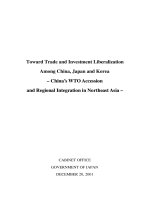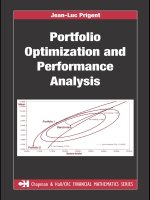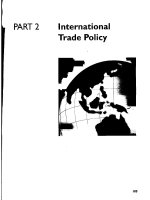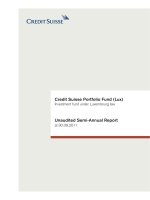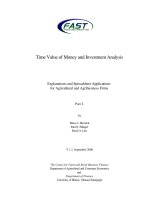Portfolio Theory and Investment Analysis
Bạn đang xem bản rút gọn của tài liệu. Xem và tải ngay bản đầy đủ của tài liệu tại đây (2.96 MB, 59 trang )
Robert Alan Hill
Portfolio Theory and Investment
Analysis
Download free books at
Download free eBooks at bookboon.com
2
Robert Alan Hill
Portfolio Theory and Investment
Analysis
Download free eBooks at bookboon.com
3
Portfolio Theory and Investment Analysis
2
nd
edition
© 2014 Robert Alan Hill &
bookboon.com
ISBN 978-87-403-0606-4
Download free eBooks at bookboon.com
Click on the ad to read more
Portfolio Theory and Investment Analysis
4
Contents
Contents
1 An Overview 6
Introduction 6
1.1 e Development of Finance 6
1.2 Ecient Capital Markets 8
1.3 e Role of Mean-Variance Eciency 10
1.4 e Background to Modern Portfolio eory 13
Summary and Conclusions 15
Selected References 16
2 Risk and Portfolio Analysis 17
Introduction 17
2.1 Mean-Variance Analyses: Markowitz Eciency 18
2.2 e Combined Risk of Two Investments 21
2.3 e Correlation between Two Investments 25
Summary and Conclusions 28
Selected References 28
www.sylvania.com
We do not reinvent
the wheel we reinvent
light.
Fascinating lighting offers an infinite spectrum of
possibilities: Innovative technologies and new
markets provide both opportunities and challenges.
An environment in which your expertise is in high
demand. Enjoy the supportive working atmosphere
within our global group and benefit from international
career paths. Implement sustainable ideas in close
cooperation with other specialists and contribute to
influencing our future. Come and join us in reinventing
light every day.
Light is OSRAM
Download free eBooks at bookboon.com
Click on the ad to read more
Portfolio Theory and Investment Analysis
5
Contents
3 he Optimum Portfolio 29
Introduction 29
3.1 e Mathematics of Portfolio Risk 30
3.2 Risk Minimisation and the Two-Asset Portfolio 33
3.3 e Minimum Variance of a Two-Asset Portfolio 36
3.4 e Multi-Asset Portfolio 37
3.5: e Optimum Portfolio 40
Summary and Conclusions 43
Selected References 45
4 he Market Portfolio 46
Introduction 46
4.1 e Market Portfolio and Tobin’s eorem 47
4.2 e CML and Quantitative Analyses 51
4.3 Systematic and Unsystematic Risk 54
Summary and Conclusions 57
5 Appendix 59
360°
thinking
.
© Deloitte & Touche LLP and affiliated entities.
Discover the truth at www.deloitte.ca/careers
Download free eBooks at bookboon.com
Portfolio Theory and Investment Analysis
6
An Overview
1 An Overview
Introduction
Once a company issues shares (common stock) and receives the proceeds, it has no direct involvement
with their subsequent transactions on the capital market, or the price at which they are traded. ese
are matters for negotiation between existing shareholders and prospective investors, based on their own
nancial agenda.
As a basis for negotiation, however, the company plays a pivotal agency role through its implementation of
investment-nancing strategies designed to maximise prots and shareholder wealth. What management
do to satisfy these objectives and how the market reacts are ultimately determined by the law of supply
and demand. If corporate returns exceed market expectations, share price should rise (and vice versa).
But in a world where ownership is divorced from control, characterised by economic and geo-political
events that are also beyond management’s control, this invites a question.
How do companies determine an optimum portfolio of investment
strategies that satisfy a multiplicity of shareholders with dierent wealth
aspirations, who may also hold their own diverse portfolio of investments?
1.1 The Development of Finance
As long ago as 1930, Irving Fisher’s Separation eorem provided corporate management with a lifeline
based on what is now termed Agency eory.
He acknowledged implicitly that whenever ownership is divorced from control, direct communication
between management (agents) and shareholders (principals) let alone other stakeholders, concerning the
likely protability and risk of every corporate investment and nancing decision is obviously impractical.
If management were to implement optimum strategies that satisfy each shareholder, the company would
also require prior knowledge of every investor’s stock of wealth, dividend preferences and risk-return
responses to their strategies.
According to Fisher, what management therefore, require is a model of aggregate shareholder behaviour.
A theoretical abstraction of the real world based on simplifying assumptions, which provides them with
a methodology to communicate a diversity of corporate wealth maximising decisions.
Download free eBooks at bookboon.com
Portfolio Theory and Investment Analysis
7
An Overview
To set the scene, he therefore assumed (not unreasonably) that all investor behaviour (including that of
management) is rational and risk averse. ey prefer high returns to low returns but less risk to more
risk. However, risk aversion does not imply that rational investors will not take a chance, or prevent
companies from retaining earnings to gamble on their behalf. To accept a higher risk they simply require
a commensurately higher return, which Fisher then benchmarked.
Management’s minimum rate of return on incremental projects nanced
by retained earnings should equal the return that existing shareholders,
or prospective investors, can earn on investments of equivalent risk
elsewhere.
He also acknowledged that a company’s acceptance of projects internally nanced by retentions, rather
than the capital market, also denies shareholders the opportunity to benet from current dividend
payments. Without these, individuals may be forced to sell part (or all) of their shareholding, or
alternatively borrow at the market rate of interest to nance their own preferences for consumption
(income) or investment elsewhere.
To circumvent these problems Fisher assumed that if capital markets are perfect with no barriers to
trade and a free ow of information (more of which later) a rm’s investment decisions can not only be
independent of its shareholders’ nancial decisions but can also satisfy their wealth maximisation criteria.
In Fisher’s perfect world:
- Wealth maximising rms should determine optimum investment decisions by nancing
projects based on their opportunity cost of capital.
- e opportunity cost equals the return that existing shareholders, or prospective investors,
can earn on investments of equivalent risk elsewhere.
- Corporate projects that earn rates of return less than the opportunity cost of capital should
be rejected by management. ose that yield equal or superior returns should be accepted.
- Corporate earnings should therefore be distributed to shareholders as dividends, or retained
to fund new capital investment, depending on the relationship between project protability
and capital cost.
- In response to rational managerial dividend-retention policies, the nal consumption-
investment decisions of rational shareholders are then determined independently according
to their personal preferences.
- In perfect markets, individual shareholders can always borrow (lend) money at the market
rate of interest, or buy (sell) their holdings in order to transfer cash from one period to
another, or one rm to another, to satisfy their income needs or to optimise their stock of
wealth.
Download free eBooks at bookboon.com
Portfolio Theory and Investment Analysis
8
An Overview
Activity 1
Based on Fisher’s Separation Theorem, share price should rise, fall, or
remain stable depending on the inter-relationship between a company’s
project returns and the shareholders desired rate of return. Why is this?
For detailed background to this question and the characteristics of perfect
markets you might care to download “Strategic Financial Management”
(both the text and exercises) from bookboon.com and look through their
rst chapters.
1.2 Ecient Capital Markets
According to Fisher, in perfect capital markets where ownership is divorced from control, the separation
of corporate dividend-retention decisions and shareholder consumption-investment decisions is not
problematical. If management select projects using the shareholders’ desired rate of return as a cut-o
rate for investment, then at worst corporate wealth should stay the same. And once this information is
communicated to the outside world, share price should not fall.
Of course, the Separation eorem is an abstraction of the real world; a model with questionable
assumptions. Investors do not always behave rationally (some speculate) and capital markets are not
perfect. Barriers to trade do exist, information is not always freely available and not everybody can
borrow or lend at the same rate. But instead of asking whether these assumptions are divorced from
reality, the relevant question is whether the model provides a sturdy framework upon which to build.
Certainly, theorists and analysts believed that it did, if Fisher’s impact on the subsequent development
of nance theory and its applications are considered. So much so, that despite the recent global nancial
meltdown (or more importantly, because the events which caused it became public knowledge) it is still
a basic tenet of nance taught by Business Schools and promoted by other vested interests world-wide
(including governments, nancial institutions, corporate spin doctors, the press, media and nancial
web-sites) that:
Capital markets may not be perfect but are still reasonably ecient with
regard to how analysts process information concerning corporate activity
and how this changes market values once it is conveyed to investors.
An ecient market is one where:
- Information is universally available to all investors at a low cost.
- Current security prices (debt as well as equity) reect all relevant information.
- Security prices only change when new information becomes available.
Download free eBooks at bookboon.com
Portfolio Theory and Investment Analysis
9
An Overview
Based on the pioneering research of Eugene Fama (1965) which he formalised as the “ecient market
hypothesis” (EMH) it is also widely agreed that information processing eciency can take three forms
based on two types of analyses.
e weak form states that current prices are determined solely by a technical analysis of past prices.
Technical analysts (or chartists) study historical price movements looking for cyclical patterns or trends
likely to repeat themselves. eir research ensures that signicant movements in current prices relative to
their history become widely and quickly known to investors as a basis for immediate trading decisions.
Current prices will then move accordingly.
e semi-strong form postulates that current prices not only reect price history, but all public information.
And this is where fundamental analysis comes into play. Unlike chartists, fundamentalists study a company
and its business based on historical records, plus its current and future performance (protability,
dividends, investment potential, managerial expertise and so on) relative to its competitive position, the
state of the economy and global factors.
In weak-form markets, fundamentalists, who make investment decisions on the expectations of individual
rms, should therefore be able to “out-guess” chartists and prot to the extent that such information is
not assimilated into past prices (a phenomenon particularly applicable to companies whose nancial
securities are infrequently traded). However, if the semi-strong form is true, fundamentalists can no
longer gain from their research.
e strong form declares that current prices fully reect all information, which not only includes all
publically available information but also insider knowledge. As a consequence, unless they are lucky,
even the most privileged investors cannot prot in the long term from trading nancial securities before
their price changes. In the presence of strong form eciency the market price of any nancial security
should represent its intrinsic (true) value based on anticipated returns and their degree of risk.
So, as the EMH strengthens, speculative prot opportunities weaken.
Competition among large numbers of increasingly well-informed market
participants drives security prices to a consensus value, which reects the
best possible forecast of a company’s uncertain future prospects.
Which strength of the EMH best describes the capital market and whether investors can ever “beat the
market” need not concern us here. e point is that whatever levels of eciency the market exhibits
(weak, semi-strong or strong):
- Current prices reect all the relevant information used by that market (price history, public
data and insider information, respectively).
- Current prices only change when new information becomes available.
Download free eBooks at bookboon.com
Portfolio Theory and Investment Analysis
10
An Overview
It follows, therefore that prices must follow a “random walk” to the extent that new information is
independent of the last piece of information, which they have already absorbed.
- And it this phenomenon that has the most important consequences for how management
model their strategic investment-nancing decisions to maximise shareholder wealth
Activity 2
Before we continue, you might nd it useful to review the Chapter so far
and briey summarise the main points.
1.3 The Role of Mean-Variance Eciency
We began the Chapter with an idealised picture of investors (including management) who are rational
and risk-averse and formally analyse one course of action in relation to another. What concerns them
is not only protability but also the likelihood of it arising; a risk-return trade-o with which they feel
comfortable and that may also be unique.
us, in a sophisticated mixed market economy where ownership is divorced from control, it follows that
the objective of strategic nancial management should be to implement optimum investment-nancing
decisions using risk-adjusted wealth maximising criteria, which satisfy a multiplicity of shareholders
(who may already hold a diverse portfolio of investments) by placing them all in an equal, optimum
nancial position.
No easy task!
But remember, we have not only assumed that investors are rational but that capital markets are also
reasonably ecient at processing information. And this greatly simplies matters for management.
Because today’s price is independent of yesterday’s price, ecient markets have no memory and individual
security price movements are random. Moreover, investors who comprise the market are so large in
number that no one individual has a comparative advantage. In the short run, “you win some, you lose
some” but long term, investment is a fair game for all, what is termed a “martingale”. As a consequence,
management can now aord to take a linear view of investor behaviour (as new information replaces
old information) and model its own plans accordingly.
What rational market participants require from companies is a diversied
investment portfolio that delivers a maximum return at minimum risk.
What management need to satisfy this objective are investment-nancing
strategies that maximise corporate wealth, validated by simple linear
models that statistically quantify the market’s risk-return trade-o.
